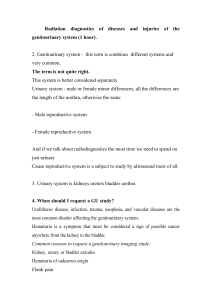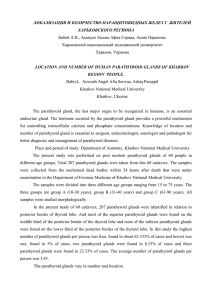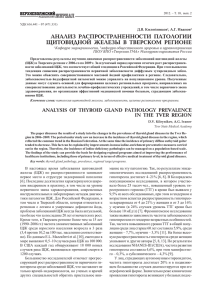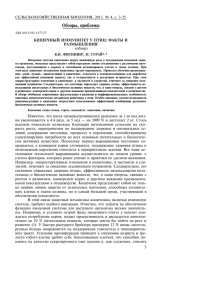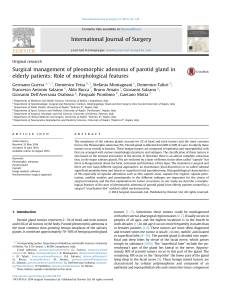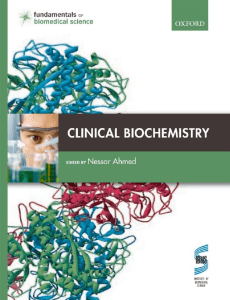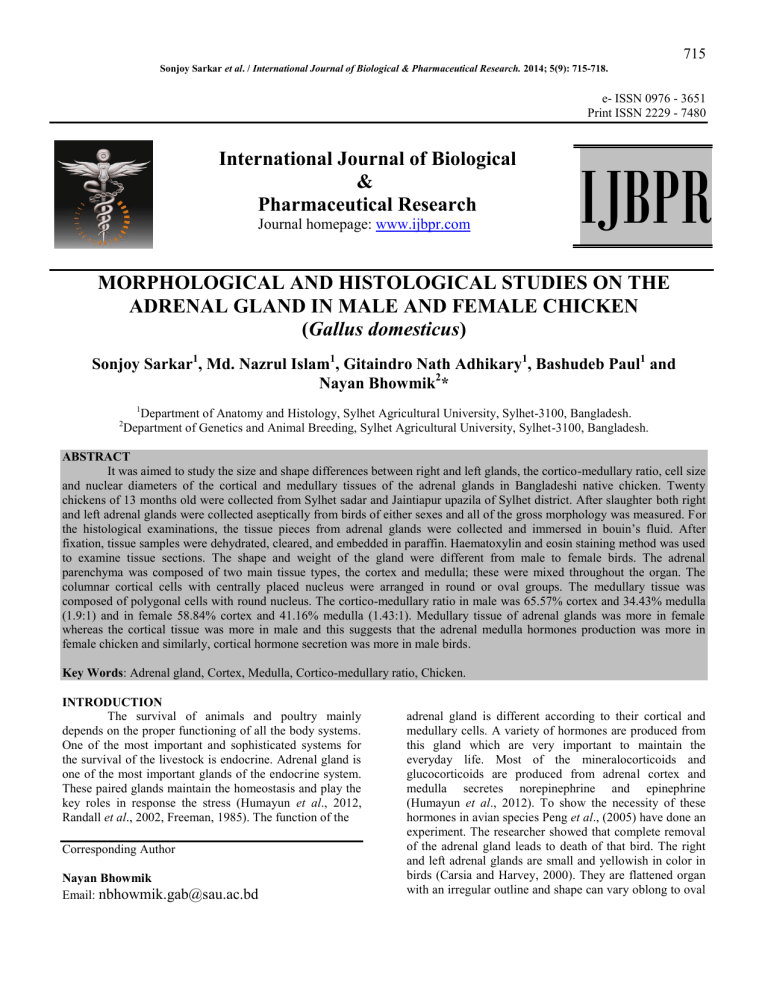
715 Sonjoy Sarkar et al. / International Journal of Biological & Pharmaceutical Research. 2014; 5(9): 715-718. e- ISSN 0976 - 3651 Print ISSN 2229 - 7480 International Journal of Biological & Pharmaceutical Research Journal homepage: www.ijbpr.com IJBPR MORPHOLOGICAL AND HISTOLOGICAL STUDIES ON THE ADRENAL GLAND IN MALE AND FEMALE CHICKEN (Gallus domesticus) Sonjoy Sarkar1, Md. Nazrul Islam1, Gitaindro Nath Adhikary1, Bashudeb Paul1 and Nayan Bhowmik2* 1 Department of Anatomy and Histology, Sylhet Agricultural University, Sylhet-3100, Bangladesh. Department of Genetics and Animal Breeding, Sylhet Agricultural University, Sylhet-3100, Bangladesh. 2 ABSTRACT It was aimed to study the size and shape differences between right and left glands, the cortico-medullary ratio, cell size and nuclear diameters of the cortical and medullary tissues of the adrenal glands in Bangladeshi native chicken. Twenty chickens of 13 months old were collected from Sylhet sadar and Jaintiapur upazila of Sylhet district. After slaughter both right and left adrenal glands were collected aseptically from birds of either sexes and all of the gross morphology was measured. For the histological examinations, the tissue pieces from adrenal glands were collected and immersed in bouin’s fluid. After fixation, tissue samples were dehydrated, cleared, and embedded in paraffin. Haematoxylin and eosin staining method was used to examine tissue sections. The shape and weight of the gland were different from male to female birds. The adrenal parenchyma was composed of two main tissue types, the cortex and medulla; these were mixed throughout the organ. The columnar cortical cells with centrally placed nucleus were arranged in round or oval groups. The medullary tissue was composed of polygonal cells with round nucleus. The cortico-medullary ratio in male was 65.57% cortex and 34.43% medulla (1.9:1) and in female 58.84% cortex and 41.16% medulla (1.43:1). Medullary tissue of adrenal glands was more in female whereas the cortical tissue was more in male and this suggests that the adrenal medulla hormones production was more in female chicken and similarly, cortical hormone secretion was more in male birds. Key Words: Adrenal gland, Cortex, Medulla, Cortico-medullary ratio, Chicken. INTRODUCTION The survival of animals and poultry mainly depends on the proper functioning of all the body systems. One of the most important and sophisticated systems for the survival of the livestock is endocrine. Adrenal gland is one of the most important glands of the endocrine system. These paired glands maintain the homeostasis and play the key roles in response the stress (Humayun et al., 2012, Randall et al., 2002, Freeman, 1985). The function of the Corresponding Author Nayan Bhowmik Email: [email protected] adrenal gland is different according to their cortical and medullary cells. A variety of hormones are produced from this gland which are very important to maintain the everyday life. Most of the mineralocorticoids and glucocorticoids are produced from adrenal cortex and medulla secretes norepinephrine and epinephrine (Humayun et al., 2012). To show the necessity of these hormones in avian species Peng et al., (2005) have done an experiment. The researcher showed that complete removal of the adrenal gland leads to death of that bird. The right and left adrenal glands are small and yellowish in color in birds (Carsia and Harvey, 2000). They are flattened organ with an irregular outline and shape can vary oblong to oval 716 Sonjoy Sarkar et al. / International Journal of Biological & Pharmaceutical Research. 2014; 5(9): 715-718. to pyramidal. Different factors are responsible for the weight, length, width and thickness of the adrenal glands. Unlike to the mammals, in chicken the cortico-medullary tissues are intermingled to each other (Ghosh et al., 2001). Basically several studies on the avian adrenal gland have already done in the world with emphasis on the basic information (Humayun, 2012, Elbajory, 2012, Basha et al., 2004 and Tang et al., 2009) but in Bangladesh there is a limited work noticed related to the adrenal gland of birds. Therefore, this experiment was done to study the size and shape differences between right and left glands, the cortico-medullary ratio, cell size and nuclear diameters of the cortical and medullary tissues of the adrenal glands of Bangladeshi native chicken. MATERIALS AND METHODS Twenty chickens (10 for each sex) of 13 months old were collected from Sylhet Sadar and Jaintiapur upazila of Sylhet district. The materials for the study were collected from both male and female chicken. After sacrifices the birds the glands were collected immediately with aseptic measures by using a scalpel. The shape, color and other morphometric data were measured and recorded. The absolute weights were measured by a digital balance. For the histological examinations, the tissue pieces from adrenal glands were collected and immersed in bouin’s fluid. After fixation, tissue samples were dehydrated, cleared, and embedded in paraffin. Haematoxylin and eosin staining protocol was used to examine tissue sections. The permanent slides were prepared according to the procedure of Drury et al., (1976). Images were captured by photomicroscope to a computer. Thickness of capsule, cortico-medullary ratio, height of the cells and diameter of the nuclei of 50 randomly selected cortical and medullary tissues were measured by stage and ocular micrometer from three different regions (subcapsular layer, peripheral and central zone). Finally the data were analysed by SPSS (Statistical Package for the Social Sciences) program and Student’s paired t-test were done to find out the differences in weight, thickness of capsule, height of the cells and diameter of the nuclei of cortical and medullary tissues between right and left adrenal glands. Differences were considered significant if P<0.05. RESULTS Gross anatomy of the adrenal glands of chicken The flattened shaped adrenal glands in chicken were located against the cranial poles of the kidney just caudal to the lung. The shape of the adrenal gland of chicken can vary to oblong to oval to pyramidal (Fig 1 & 2). The ventral surface of the glands lies against the testicles in the adult male bird. But in the adult female birds, the ovary fully covered the ventral surface of the left adrenal glands. The weight of the right adrenal glands of the male and female chicken were 0.070.005g and 0.090.005g and the left glands were 0.090.004g and 0.110.011g, respectively (Table 1). Histology of the adrenal glands Capsule and trabeculae The capsule of the adrenal gland of chicken was thin and formed by dense connective tissue (Fig 3 & 4). Thin trabeculae originated from the capsule penetrate the parenchyma of the gland (Fig 5). Fibroblastic cell, blood vessel and nerve vessels were also found in the capsule of the chicken (Fig 4). The average thickness of the capsule of the male and female were 20.941.143µm and 24.830.969µm, respectively (Table 2). Cortex of adrenal gland The cortical and the medullary cell were intermingled (Fig 3, 5 & 6). But the cortical cells were larger in proportion than in medullary counterpart in both sex of chicken. The cortical cells were arranged in round or oval groups. The cells were mostly columnar with nuclei in the center. The average cortico-medullary ratios in male and female chicken were 65.57%:34.43% and 58.84%:41.16%, respectively (Table 1). Sinusoidal capillaries were also found in between the corticomedullary cells. The cortical cell height and diameter of nucleus in male, and female were 8.960.159µm and 4.260.166µm, and 10.570.628µm and 3.690.087µm, respectively (Table 2). Medulla of adrenal gland The medullary tissue was composed of polygonal cells. They are larger than the cortical cells and possess a large, round nucleus (Fig 6). Ganglionic cell was also found among the medullary cells. The average height of medullary cell and diameter of nucleus in male, and female were 8.720.231µm and 4.390.359µm, and 8.670.218 µm and 3.840.326µm, respectively (Table 2). The medullary cells were smaller in proportion than the cortical cells. Table 1. Mean ( SD) weight and Cortico-medullary ratio of the adrenal glands in male and female chicken (n=20) Av. Weight of the adrenal Av. Weight Cortico-medullary ratio No. of Age glands (g)±SD Name of Species of the birds Birds (Months) (g) Right Left % of cortex % of medulla Male 10 13 1680 65.57 34.43 0.070.005* 0.090.004 Female 10 13 1550 58.84 41.16 0.090.005* 0.110.011 Asterisk (*) indicates significant difference (Paired t-test, * P<0.05) 717 Sonjoy Sarkar et al. / International Journal of Biological & Pharmaceutical Research. 2014; 5(9): 715-718. Table 2. MeanSD of different parameters in Male and Female (n=20) Cortex Thickness Diameter of of capsule Height of cell Name of Species nucleus MeanSD MeanSD (µm) MeanSD (µm) (µm) Male 20.941.143* 8.960.159 4.260.166* Female 24.830.969 10.570.628 3.690.087 Asterisk (*) indicates significant difference (Paired t-test, * P<0.05). Medulla Height of cell MeanSD (µm) 8.720.231* 8.670.218 Diameter of nucleus MeanSD (µm) 4.390.359* 3.840.326 Figure 1. Adrenal gland of chicken (A) superior to the kidney, ventral view Figure 2. Adrenal gland of chicken Figure 3. Adrenal gland of adult chicken showing Capsule (C), Sinusoid (SS), Cortex (CT) and Medulla (M). H & E stains X 33 Figure 4. Adrenal gland of adult chicken showing Capsule (C), Fibroblast cell (FC), Cortex (CT) and Blood vessel (BV). H & E stains X 825 Figure 5. Adrenal gland of adult chicken showing Cortex (CT), Blood vessel (BV), Trabeculae (TB) and Medulla (M). H & E stains X 82.5 Figure 6. Adrenal gland of Adult Chicken Showing Polygonal cell (PC), Medullary Cell (MC), Medullary Nucleus (MN), Sinusoid (SS), Blood Cell (BC), Columnar Cell (CL), Cortical Cell (CC) and Cortical Nucleus (CN). H & E stains X 825 718 Sonjoy Sarkar et al. / International Journal of Biological & Pharmaceutical Research. 2014; 5(9): 715-718. DISCUSSION In this study, we examined the general morphology and histology of the deshi chicken’s (Gallus domesticus) adrenal gland. The anatomical location of the adrenal glands was similar to the description of Humayun et al., (2012) and Bacha and Bacha (2000). The recorded shape and color were supported by Humayun et al (2012) and Aire (1980). The weight of the right glands was lighter than the left one in both sexes and there was a significant variation present among right and left glands (P<0.05). The reported statistical data of Humayun et al., (2012), Tang et al., (2009), Hodges, (1974) and Wells and Wight, (1971) were similar to this finding. Histologically the adrenal gland was encapsulated by the thin connective tissue capsule with blood vessels and the cortex and medulla were intermingled with each other and distributed in subcapsular, peripheral and central region (Humayun et al., 2012, Holmes and Cronshaw, 1980 and Hodges, 1974). The mean thickness of the capsule was thinner in male than that of female and among them a significant difference was present (P<0.05). The cortical cells were arranged in round or oval groups but Aire (1980) suggested that the chicken’s adrenal cortical cells were arranged in column. Significant variation didn’t found in cortical cell height but differences recorded in nuclear diameter of cortical cells. The mean diameter of the cortical cell nucleus was smaller than the results of Tang et al., (2009) and Hodges, (1974). Significant differences found in medullary cell height and nuclear diameter in male and female. The diameter of medullary cell nucleus was also smaller than the findings of Tang et al., (2009) and Hodges, (1974). The corticomedullary ratio of female was supported by Humayun et al., (2012) but not supported by Carsia et al., (1985) and Aire, (1980) but in male, it was not supported by Humayun et al., (2012), Carsia et al., (1985) and Aire, (1980). CONCLUSION The histoarchitectural features of adrenal glands of chicken vary with their sex. Medullary portion was more in female whereas the cortical portion was more in male. This suggests that the adrenal glands medullary hormones production was more in female chicken and similarly cortical hormone secretion was more in male birds. However, future investigation related to the ultrastructure and immunohistochemistry will reveal the specific structural function of the gland. ACKNOWLEDGEMENTS The authors are grateful to the Department of Anatomy and Histology, Sylhet Agricultural University, Bangladesh for providing all essential facilities to carry out the study. REFERENCES Aire TA. Morphometric study of the avian adrenal gland. J Anat. 1980; 131: 19-23. Bacha WJ, Bacha LM. Color Atlas of Veterinary Histology. Second edition. Pp. Lippincott Williams and Wilkins Company. 2000. Basha SH, Vijayaragavan C, Ramesh G. Light and electron microscopic studies on the interrenal tissue of the adrenal gland in Japanese quail (Coturnix coturnix japonica). Ind J Anim Sci. 2004; 74: 1021-1023. Carsia RV, Harvey S. Adrenal glands. In: Sturkie’s avian physiology (Whittow GC ed). Fifth edition. Pp. 489-537. Academic press. New York, 2000. Drury RAB, Wallington EA, Sir Cameron R. General staining procedure. In: Carlenton’s Histological technique. Oxford University Press. London, 1976. Elbajory SIA. Morphometric study of the adrenal gland of the adult Sudanese Chicken (Gallus domesticus) and Duck (Anas platyrhynchos). Cur Res J Biol Sci. 2012; 4: 239-241. Freeman BM. Stress and the domestic fowl: Physiological fact or fancy? World’s Poult J. 1985; 41: 45-51. Ghosh A, Carmichael SW, Mukherjee M. Avian adrenal medulla: cytomorphology and function. Act Biol Szeg. 2001; 45: 1-11. Hodges RD. The adrenal glands. In: The histology of the fowl.pp.464-474. Academic Press. London, 1974. Holmes WN, Cronshaw J. Adrenal cortex: structure and function. In: Avian endocrinology (Epple and Stetson M eds). Pp.271299. Academic Press. New York. 1980. Humayun KAKM, Aoyama M, Sugita S. Morphological and Histological studies on the adrenal gland of the chicken (Gallus domesticus). J Poult Sci. 2012; 49: 39-45. Ohmori Y. Localization of biogenic amines and neuropeptides in adrenal medullary cells of birds. Horm Metab Res. 1998; 30: 384-388. Peng KM, Cfemale YX, Liang ZS. Anatomy of the domestic animals and fowls. Higher Education Press. Beijing. 2005. Randall D, Burggren W, French K. Glands and Hormones. In: Animal Physiology: Mechanisms and Adaptations, Fifth Edition. Pp 332-339. Freeman and Company. New York. 2002. Tang L, Peng KM, Wang JX, Luo HQ, Cfemaleg JY, Zhang GY, Sun YF, Liu HZ, Song H. The morphological study on the adrenal gland of African ostrich chicks. Tissue and cell. 2009; 41: 231-238. Wells JW, Wight PAL. The adrenal glands. In: Physiology and biochemistry of the domestic fowl (Bell DJ and Freeman GM eds.). pp. 489-520. Academic Press. London. 1971.
